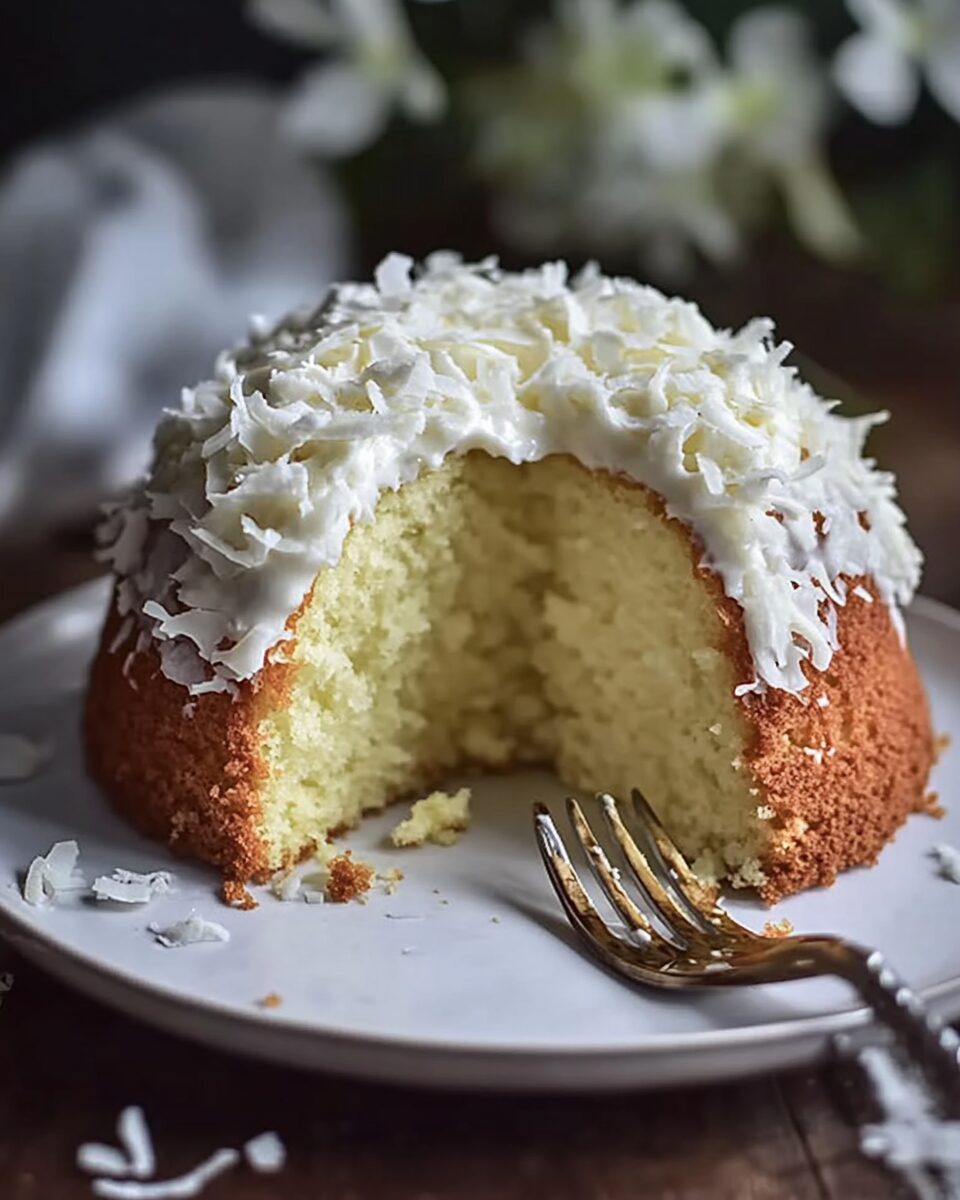Indulge in a taste of tropical paradise with this coconut milk cake that combines a velvety texture with a deep, sweet coconut flavor. This luscious cake is enriched with both shredded coconut and coconut milk, delivering an irresistibly moist and tender crumb. Each bite offers the pure, blissful flavor of coconut, making it the ideal dessert for coconut enthusiasts and dessert lovers alike.
Whether enjoyed with afternoon tea, a celebratory occasion, or as an after-dinner treat, this coconut milk cake will transport you to a blissful island setting with its tropical charm and luxurious texture. The simplicity of its ingredients lets the rich coconut shine, while the subtle vanilla essence enhances the flavors beautifully. Share it with family and friends to spread a little sweetness and warmth, bringing a taste of the tropics to your table.
Full Recipe:
- 1 cup coconut milk
- 1 cup unsweetened shredded coconut
- 2 1/4 cups all-purpose flour
- 1/2 teaspoon baking powder
- 1/2 teaspoon baking soda
- 1/4 teaspoon salt
- 1/2 cup unsalted butter, softened
- 1/2 cup coconut oil, melted
- 1 3/4 cups white sugar
- 4 large eggs
- 1 teaspoon vanilla extract
- 1/2 teaspoon coconut extract (optional)
Directions:
- Preheat your oven to 350°F (175°C). Grease and flour a 9×13-inch baking dish.
- In a bowl, combine flour, baking powder, baking soda, and salt, then whisk until evenly mixed.
- In a separate large bowl, beat the softened butter and coconut oil together until fluffy. Gradually add in the sugar, continuing to beat until the mixture is light and airy.
- Add eggs, one at a time, beating well after each addition. Stir in vanilla and coconut extracts.
- Slowly alternate adding the flour mixture and coconut milk to the wet ingredients, beginning and ending with the flour mixture. Gently fold in the shredded coconut.
- Pour batter into the prepared baking dish, smoothing the top evenly. Bake for 35-40 minutes, or until a toothpick inserted into the center comes out clean.
- Allow the cake to cool completely before serving, letting the flavors set and enrich the texture.
Prep Time: 20 minutes | Cooking Time: 40 minutes | Total Time: 1 hour
Kcal: 310 kcal per serving | Servings: 12 servings
The Allure of Coconut Milk Cake
Coconut milk cake is not just a dessert; it’s a delightful experience that brings a taste of the tropics to any table. Known for its rich flavor and moist texture, this cake embodies the essence of coconut in every bite. The use of coconut milk adds a creamy, luscious quality that elevates the cake beyond a standard dessert, making it a favorite among coconut enthusiasts and dessert lovers alike. Whether served at a family gathering, a birthday celebration, or simply enjoyed during a quiet afternoon, coconut milk cake has a universal appeal that transcends borders.
Historical Context
Coconut milk has been a staple ingredient in many cuisines around the world, particularly in tropical regions. It is derived from the flesh of mature coconuts and has a rich, creamy texture that makes it versatile for both savory and sweet dishes. In Southeast Asia, coconut milk is often used in curries, desserts, and beverages. The Caribbean also boasts a variety of coconut-based dishes, showcasing the fruit’s cultural significance.
The historical roots of coconut milk cake can be traced back to the use of coconut in indigenous cooking. In many tropical cultures, the coconut tree is often referred to as the “tree of life,” as nearly every part of the tree can be utilized, from the fruit to the leaves and even the wood. In baking, coconut milk became popular due to its ability to add moisture and richness to cakes, making it an excellent substitute for regular milk or cream.
As trade routes expanded, the coconut spread across the globe, introducing this versatile ingredient to various culinary traditions. The influence of European baking techniques melded with tropical flavors, leading to the creation of delightful desserts like coconut milk cake. Today, recipes for coconut cake can be found in cookbooks from the Caribbean to Southeast Asia, each with its own unique twist on this beloved treat.
The Appeal of Coconut Flavor
The unique flavor profile of coconut milk cake is one of its most appealing aspects. Coconut milk brings a sweet, tropical flavor that can be both comforting and exotic. The addition of shredded coconut enhances the cake’s texture, providing delightful morsels of coconut in every bite. This contrast between the moist cake and the chewy coconut flakes creates an enjoyable eating experience.
The aroma of baking coconut cake is also enticing, filling the kitchen with a warm, inviting scent that beckons everyone to gather around. This makes it an ideal dessert for family gatherings, celebrations, or even casual afternoons with friends. The nostalgia associated with coconut often evokes memories of summer vacations, beach trips, and festive occasions, making this cake not just a treat, but a cherished reminder of happy times.
Variations and Customizations
One of the great things about coconut milk cake is its versatility. Here are some ideas for variations that you can try to personalize your cake:
- Flavored Extracts: While vanilla and coconut extracts are classic choices, you can experiment with other flavors such as almond or rum to add an interesting twist to your cake. A hint of almond extract can bring a delightful depth of flavor, while a splash of rum can evoke the essence of a tropical cocktail.
- Fruit Additions: Consider folding in diced pineapple or mango for a fruity burst. Fresh fruits can complement the coconut flavor beautifully and add a refreshing element to the cake. Pineapple, in particular, pairs wonderfully with coconut, creating a tropical symphony of flavors that is reminiscent of piña colada.
- Frosting Options: While a simple glaze of coconut milk and powdered sugar is delightful, you can also opt for a cream cheese frosting or a whipped coconut cream topping. Each frosting can change the cake’s overall flavor and texture, so feel free to experiment! For a richer taste, a cream cheese frosting can add tanginess that balances the sweetness of the cake.
- Layering: For a more sophisticated presentation, you can make a layered cake by baking the coconut cake in two or three round pans. Fill the layers with whipped cream, fruit, or a coconut cream filling for a show-stopping dessert. Layering not only adds visual appeal but also creates a delightful contrast in textures with each bite.
- Gluten-Free Version: For those with dietary restrictions, substituting all-purpose flour with a gluten-free blend can make this cake accessible to everyone. Gluten-free flours such as almond flour or coconut flour can create a deliciously moist cake, though the texture may vary slightly from the traditional version.
- Vegan Options: For a vegan twist, replace eggs with flaxseed meal or chia seeds mixed with water. Additionally, use plant-based butter and coconut milk. This way, everyone can enjoy a slice of this delectable cake, regardless of dietary preferences.
Serving Suggestions
Coconut milk cake can be served in various settings, making it a versatile dessert. Here are a few ideas for serving:
- Tea Time Treat: Serve slices alongside a pot of tea for an elegant afternoon tea experience. The lightness of the cake pairs perfectly with a variety of teas, enhancing the overall experience. Consider serving it with a delicate Earl Grey or a fruity herbal tea to complement the coconut flavors.
- Celebratory Desserts: For birthdays or special occasions, decorate the cake with tropical fruits or edible flowers. This not only enhances its visual appeal but also adds to the tropical theme. Fresh slices of kiwi, mango, and strawberries can create a vibrant and festive look, making the cake the centerpiece of any celebration.
- Brunch Favorite: This cake can also shine at brunches. Serve it with a side of fresh fruit and whipped cream for a sweet and satisfying start to the day. Pairing it with a light yogurt or a tropical smoothie can create a refreshing and balanced brunch spread.
- Comfort Dessert: Pair it with a scoop of vanilla ice cream or a dollop of whipped cream for a comforting dessert after a hearty meal. The contrast of the warm cake and cold ice cream is an irresistible combination, providing a delightful end to any dinner.
- Picnic Treat: Coconut milk cake is also perfect for outdoor gatherings. It holds up well when transported, making it an ideal addition to picnics or potlucks. Slice it into squares for easy serving, and enjoy it under the sun with friends and family.
The Cultural Significance of Coconut
Coconuts hold a special place in many cultures around the world, often symbolizing life, fertility, and prosperity. In Hindu culture, coconuts are considered sacred and are used in various rituals and celebrations. They are often offered to deities as a symbol of purity and as a means of seeking blessings.
In the Caribbean, the coconut tree is sometimes referred to as the “tree of life,” as it provides food, drink, and shelter. Coconuts are a crucial part of local diets and cuisines, appearing in dishes ranging from curries to desserts. Festivals and celebrations often feature coconut-based dishes, highlighting the fruit’s cultural importance.
This cultural significance adds an extra layer of appreciation when baking and enjoying coconut milk cake. Each slice can remind us of the traditions and stories surrounding the coconut, connecting us to a broader culinary heritage.
Tips for Baking the Perfect Coconut Milk Cake
To ensure your coconut milk cake turns out perfectly every time, consider the following tips:
- Use Quality Ingredients: The flavor of your cake will greatly depend on the quality of your ingredients. Use fresh coconut milk and high-quality shredded coconut. If possible, choose unsweetened shredded coconut for a more authentic flavor.
- Room Temperature Ingredients: Ensure that your butter and eggs are at room temperature before you start mixing. This helps create a smooth batter and contributes to a lighter, fluffier cake.
- Don’t Overmix: When combining wet and dry ingredients, mix just until combined. Overmixing can lead to a dense cake. Gently fold in the shredded coconut at the end to maintain its texture.
- Check for Doneness: Baking times may vary based on your oven and the type of pan used. Always check for doneness by inserting a toothpick into the center of the cake; it should come out clean when the cake is fully baked.
- Cooling Time: Allow the cake to cool completely in the pan before transferring it to a wire rack. This helps prevent it from breaking apart and ensures a smooth frosting application.
Storage Tips
Coconut milk cake can be stored in an airtight container at room temperature for a few days. If you want to keep it fresh for longer, consider refrigerating it, which can extend its shelf life up to a week. To maintain the cake’s moisture, you may want to cover it with plastic wrap or aluminum foil.
For longer storage, you can freeze slices of the cake. Wrap each slice in plastic wrap, then place it in a freezer bag. When you’re ready to enjoy it, simply thaw at room temperature or warm it gently in the oven. This makes it a great make-ahead option for gatherings or special occasions.
Conclusion
Coconut milk cake is more than just a dessert; it’s a celebration of flavors and textures that transport you to a tropical paradise with every bite. Its moist, fluffy consistency, combined with the sweet, rich flavor of coconut, makes it a memorable addition to any gathering. Whether you enjoy it plain or dress it up with toppings and fillings, this cake is sure to impress your family and friends.
By understanding its background, experimenting with variations, and learning how to serve it creatively, you can elevate this simple cake into a stunning centerpiece for any occasion. The versatility and cultural significance of coconut milk cake allow it to adapt to different celebrations and personal preferences, making it a beloved recipe in your collection.






